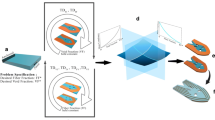Abstract
The popular Solid Isotropic Material Penalization (SIMP) technique of topology design is extended to simultaneous fiber-angle and topology design of composite laminae in a cellular automata (CA) framework. CA is a novel methodology to simulate a physical phenomenon based on iterative local updates of both field and design variables. Displacements are updated satisfying local equilibrium of CA cells. Fiber angles and density measures are updated based on the optimality criteria for the minimum compliance design. Numerical results for the design of 2D cantilever plates for single and multiple load cases are used to demonstrate the robustness of the proposed algorithm.
Similar content being viewed by others
References
Abdalla-2002 Abdalla M, Gürdal Z (2002) Structural design using optimality based cellular automata. In: Proceedings of the 43rd AIAA/ASME/ASCE/AHS conference on structures, structural dynamics, and materials, Denver, CO
Abdalla-2004-a Abdalla M, Gürdal Z (2004) Structural design using cellular automata for eigenvalue problems. Struct Multidisc Optim 26:200–208
Abdalla-2004-b Abdalla MM, Kim S, Gürdal Z, Jones M (2004) Multigrid accelerated cellular automata for structural design optimization: a 1-D implementation. In: Proceedings of the 45th AIAA/ASME/ASCE/AHS/ASC conference on structures, structural dynamics and materials, Palm Springs, CA
Banichuk-1979 Banichuk NV (1979) Optimization of anisotropic properties of deformable media in plane problems of elasticity. Mech Solids 14:63–68
Barlow-1976 Barlow J (1976) Optimal stress locations in finite element models. Int J Numer Methods Eng 10:243–251
Bendsoe-2003 Bendsøe MP, Sigmund O (2003) Topology optimization, theory, methods and applications. Springer, Berlin Heidelberg New York
Duvaut-2000 Duvaut G, Terrel G, Léné F, Verijenko VE (2000) Optimization of fiber reinforced composites. Composite Struct 48:83–89
Gurdal-2000 Gürdal Z, Tatting B (2000) Cellular automata for design of truss structures with linear and nonlinear response. In: Proceedings of the 41st AIAA/ASME/ASCE/AHS conference on structures, structural dynamics, and materials, Atlanta, GA
Hansel-1999 Hansel W, Becker W (1999) Layerwise adaptive topology optimization of laminate structures. Eng Comput 16:841–851
Hyer-1989 Hyer MW, Charette RF (2000) Use of curvilinear fiber format in composite structure design. In: Proceedings of the 30th conference on structures, structural dynamics, and material, Mobile, AL
Katz-1989 Katz Y, Haftka RT, Altus E (1989) Optimization of fiber directions for increasing the failure load of a plate with a hole. In: Proceedings of the ASC technical conference, 4:62–71
Landriani-1991 Landriani GS, Rovati M (1991) Optimal design for two-dimensional structures made of composite materials. Trans ASME 113:88–92
Liang-2002 Liang QQ, Steven GP (2002) A performance-based optimization method for topology design of continuum structures with mean compliance constraints. Comput Methods Appl Mech Eng 191:1471–1489
Lowekamp-1995 Lowekamp BB, Watson LT, Cramer MS (1995) The cellular automata paradigm for the parallel solution of heat transfer problems. Parallel Algorithms Appl 9:119–130
Nagendra-1995 Nagendra S, Kodiyalam S, Davis JE (1995) Optimization of tow fiber paths for composite design. In: Proceedings of the 36th AIAA/ASME/ASCE/AHS/ASC conference on structural dynamics, and material, New Orleans, LA
Parnas-2003 Parnas L, Oral S, Ceyhan U (2003) Optimum design of composite structures with curved fiber courses. Composite Sci Technol 63:1071–1082
Pedersen-1989 Pedersen P (1989) On optimal orientation of orthotropic materials. Struct Optim 1:101–106
Pedersen-1990 Pedersen P (1990) Bounds on elastic energy in solids of orthotropic materials. Struct Optim 2:55–63
Pedersen-1991 Pedersen P (1991) On thickness and orientational design with orthotropic materials. Struct Optim 3:69–78
Pedersen-2003 Pedersen P (2003) Examples of density, orientation, and shape-optimal 2D design for stiffness and/or strength with orthotropic materials. Struct Multidisc Optim 26:37–49
Preston-1984 Preston K, Duff MJB (1984) Modern cellular automata, theory and applications. Plenum, New York
Reddy-1997 Reddy JN (1997) Mechanics of laminate composite plates, theory and analysis. CRC Press, Boca Raton, FL
ZhuRozvany Rozvany GIN (2001) Aims, scope, methods, history and unified terminology of computer-aided topology optimization in structural mechanics. Struct Multidisc Optim 21:90–108
Rozvany-2002 Rozvany G, Querin O, Pomezanski V (2002) Extended optimality in topology design. Struct Multidisc Optim 24:257–261
Setoodeh-2003 Setoodeh S, Gürdal Z (2003) Design of composite layers with curvilinear fiber paths using cellular automata. In: Proceedings of the 44th AIAA/ASME/ASCE/AHS conference on structures, structural dynamics, and materials, Norfolk, VA
Setoodeh-2004 Setoodeh S, Adams DB, Gürdal Z, Watson LT (2004) Pipeline implementation of cellular automata for structural design on message-passing multiprocessors. Math Comput Model (in press)
Slotta-2002 Slotta DJ, Tatting B, Watson LT, Gürdal Z, Missoum, S (2002) Convergence analysis for cellular automata applied to truss design. Eng Comput 19:953–969
Tatting-2000 Tatting B, Gürdal Z (2000) Cellular automata for design of two-dimensional continuum structures. In: Proceedings of the 8th AIAA/USAF/NASA/ISSMO symposium on multidisciplinary analysis and optimization, Long Beach, CA
Tovar-2004 Tovar A, Patel N, Kaushik AK, Letona GA, Renaud JE (2004) Hybrid cellular automata: a biologically-inspired structural optimization technique. In: Proceedings of the 10th AIAA/ISSMO multidisciplinary analysis and optimization conference, Albany, NY
Wahle-2001 Wahle J, Neubert L, Esser J, Schreckenberg M (2001) A cellular automaton traffic flow model for online simulation of traffice. Parallel Comput 27:719–735
Wiener-1946 Wiener JR, Rosenbluth A (1946) The mathematical formulaion of the problem of conduction of impulses in a network of connected excitable elements, specifically in cardiac muscle. Arch Inst Cardiol Mexico 16:205–265
Author information
Authors and Affiliations
Corresponding author
Rights and permissions
About this article
Cite this article
Setoodeh, S., Abdalla, M. & Gürdal, Z. Combined topology and fiber path design of composite layers using cellular automata. Struct Multidisc Optim 30, 413–421 (2005). https://doi.org/10.1007/s00158-005-0528-y
Received:
Revised:
Published:
Issue Date:
DOI: https://doi.org/10.1007/s00158-005-0528-y




